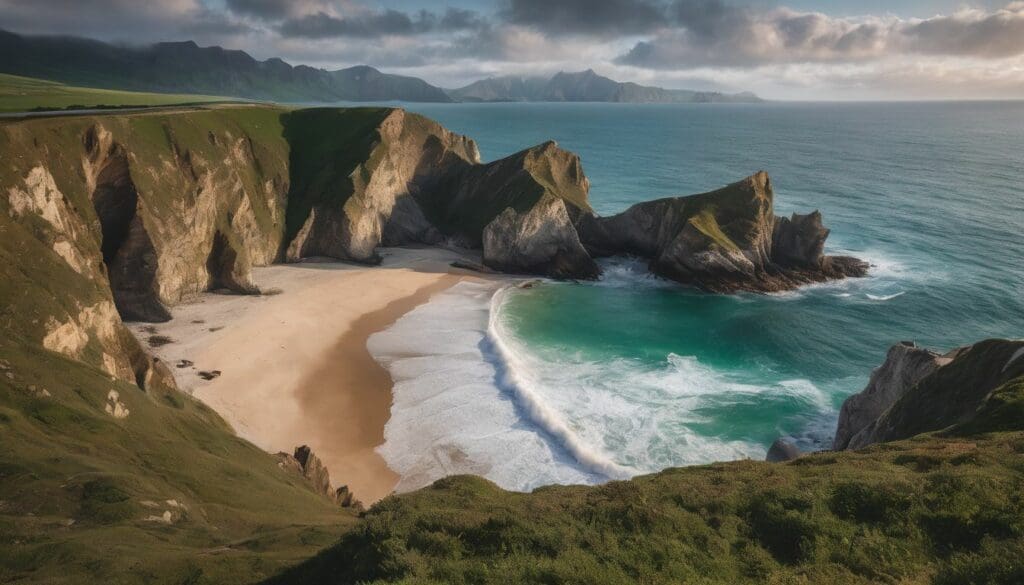As shores vanish and tides creep closer to our homes, rising sea levels become a pressing concern. Every year, the sea climbs roughly 3.3 millimetres globally, a stark reminder of our warming planet.
This article offers insights into this watery rise and hands us keys to unlock effective responses to safeguard our coastal cradles. Let’s dive in and find out how we can stem the tide together.
Key Takeaways
- Rising sea levels are mainly caused by the melting of ice caps and glaciers, along with the thermal expansion of seawater as it warms.
- Low – lying areas face severe risks from rising seas, including increased flooding, erosion, and saltwater intrusion into freshwater supplies, impacting ecosystems and human livelihoods.
- Human activities such as burning fossil fuels contribute significantly to global warming, which in turn accelerates sea level rise; immediate action is needed to reduce these emissions.
- By 2050, sea levels could rise by 30 cm to 60 cm if current trends continue; this poses a significant threat to coastal cities’ infrastructure and populations.
- Adaptation strategies like building resilient infrastructure, enhancing natural barriers such as mangroves, and embracing sustainable development are critical for mitigating the impacts of rising sea levels.
The Facts of Rising Sea Levels
Rising sea levels are primarily caused by the thermal expansion of the ocean and the melting of ice caps and glaciers. This phenomenon has far-reaching consequences for low-lying areas, including coastal flooding, erosion, and saltwater intrusion.
Causes
Global warming is heating our planet, and it’s a key driver of rising sea levels. As global temperatures climb, ice caps and glaciers melt faster than before. This fresh water flows into the oceans, gradually raising their levels.
Not only are the great icy expanses in places like Greenland and Antarctica losing mass, but even smaller glaciers around the world contribute to this increase.
Sea levels also rise due to thermal expansion; as ocean waters warm up because of higher air temperatures, they expand. Oceans warming means more space taken by the same amount of water – similar to how mercury climbs up a thermometer on a hot day.
Alongside melting ice, carbon emissions play a significant role too – they not only trap heat in our atmosphere but also lead to ocean acidification which affects marine life balance and health of coastal ecosystems.
These factors combined set the scene for ongoing changes that have far-reaching impacts on global coastlines and communities living near them.
Consequences
Sea level rise has dire consequences for low-lying areas, causing increased flooding and erosion. Rising sea levels can also lead to saltwater intrusion into freshwater sources, impacting ecosystems and drinking water supplies.
Additionally, the thermal expansion of the ocean contributes to increasing sea levels, posing a threat to coastal communities and infrastructure.
The impact of rising sea levels is exacerbated by human-caused global warming, which accelerates the process. Melting ice caps and ocean heat content further exacerbate the problem, leading to environmental degradation and an increased risk of extreme weather events in vulnerable coastal regions.
Understanding Sea Level Rise
Sea level rise has significant impacts on low-lying areas, leading to erosion, flooding, and increased saltwater intrusion. Additionally, ocean heat content and thermal expansion contribute to the rising sea levels, posing a threat to coastal communities.
Impact on low-lying areas
Rising sea levels have a significant impact on low-lying areas, causing erosion and flooding. The increased saltwater intrusion damages freshwater sources, threatening the delicate balance of ecosystems in low-lying wetlands.
Furthermore, ocean heat content and thermal expansion contribute to the environmental impact, affecting the natural habitats and biodiversity of these vulnerable regions.
Shoreline erosion poses a threat to coastal communities as rising sea levels exacerbate the loss of land. The effects on infrastructure and population in low-lying areas are profound.
Erosion and flooding
Rising sea levels lead to erosion and flooding, causing extensive damage to coastal areas. This has severe implications for surrounding ecosystems and communities.
- Erosion occurs as the higher water levels wear away at the land, leading to the loss of valuable habitats and vegetation.
- Flooding becomes more frequent and severe, impacting homes, businesses, and infrastructure in low-lying areas.
- Coastal erosion worsens during storm events and high tides, exacerbating the risk of flooding and property damage.
- The increased presence of saltwater due to flooding compromises freshwater sources and agricultural land in coastal regions.
- Human activities that contribute to global warming further intensify erosion and flooding by accelerating sea level rise.
Increased saltwater intrusion
Rising sea levels are leading to increased saltwater intrusion into freshwater sources, impacting ecosystems and communities. Saltwater is seeping into coastal aquifers and wetlands, contaminating drinking water supplies and threatening the delicate balance of estuarine habitats.
This intrusion jeopardises agriculture, as saline water damages crops and reduces soil fertility, posing a significant challenge for food security in affected regions. Adaptation measures such as building desalination plants or utilising salt-tolerant crop varieties will be vital in mitigating the effects of this growing threat.
The rising sea levels are causing increased saltwater intrusion which is affecting not only natural habitats but also human activities such as agriculture and access to clean drinking water.
Ocean heat content and thermal expansion
Ocean heat content has been rising as a result of global temperature increase, primarily caused by human activities and greenhouse gas emissions. This increase in heat causes the oceans to expand thermally, contributing significantly to rising sea levels.
The thermal expansion of the sea leads to a range of repercussions for low-lying wetlands and coastal communities, including erosion, flooding, and saltwater intrusion. Understanding the impact of ocean heat content and thermal expansion is crucial in addressing the imminent threat of rising sea levels.
The expanding ocean due to increased ocean heat content directly impacts low-lying areas worldwide through shoreline erosion and potential flooding. As temperatures continue to rise globally, so does the risk for more severe consequences affecting these vulnerable regions.
The Link Between Global Warming and Rising Sea Levels
Human-caused global warming is leading to the acceleration of sea level rise, making it crucial for us to understand this link in order to take action against rising sea levels. Want to learn more about the connection between global warming and rising sea levels? Keep reading!
Human-caused global warming
Human activities, such as burning fossil fuels and deforestation, release greenhouse gases into the atmosphere. These gases trap heat and lead to an increase in global temperatures, a phenomenon known as human-caused global warming.
This warming is directly linked to rising sea levels due to thermal expansion of the oceans and the melting of ice caps and glaciers.
The consequences of human-caused global warming are far-reaching, impacting low-lying wetlands, coastal communities, and ocean ecosystems. Understanding this link is crucial for taking action against rising sea levels.
Acceleration of sea level rise
The acceleration of sea level rise is a significant concern attributed to global warming. Ocean warming leads to the expansion of seawater, resulting in an increased volume and subsequently higher sea levels.
This escalation threatens low-lying wetlands and coastal communities, leading to erosion, flooding, and saltwater intrusion into freshwater sources. The impact on infrastructure and population in coastal cities could be severe if action is not taken promptly.
Additionally, ocean heat content plays a vital role in accelerating sea level rise due to thermal expansion. Understanding this link between global warming and rising sea levels underscores the urgency for individuals to take active steps towards conservation efforts that reduce carbon emissions and mitigate climate change’s adverse effects.
The Threat of Rising Sea Levels to Coastal Cities
Projected sea level rise by 2050 poses a significant threat to infrastructure and population in coastal cities. Find out more about the potential impacts and the importance of adaptation in our blog.
Projected sea level rise by 2050
Scientists predict that global sea levels could rise by up to 30 cm to 60 cm by the year 2050. This projection takes into account the acceleration of ice melt and the continued thermal expansion of seawater as the planet warms.
Here is a summary of the projected sea level rise by 2050:
| Year | Lower Estimate (cm) | Higher Estimate (cm) |
|---|---|---|
| 2025 | 5 | 10 |
| 2030 | 10 | 20 |
| 2040 | 15 | 35 |
| 2050 | 30 | 60 |
Coastal communities must prepare for the higher end of this scale, as current emissions could lead to more rapid ice sheet loss. Adaptation strategies are essential to minimise the impact on millions who live close to the coast.
Potential impacts on infrastructure and population
Rising sea levels pose a significant threat to coastal cities and their infrastructure. Flooding and erosion have the potential to cause widespread damage to roads, buildings, and other critical facilities, disrupting daily life for local populations.
Low-lying wetlands face the risk of submersion, impacting not only the natural environment but also essential infrastructure like water treatment plants and power stations.
Coastal communities are particularly vulnerable to the impacts of rising sea levels. Increased salinity in freshwater sources can affect drinking water supplies and agricultural land, endangering the health and livelihoods of local populations.
The importance of adaptation
Adaptation to rising sea levels is crucial for the protection of low-lying wetlands and coastal communities. Developing strategies to mitigate the impact of sea level rise, such as building resilient infrastructure and implementing coastal zoning regulations, is essential in safeguarding these vulnerable areas.
Additionally, promoting sustainable development and enhancing natural barriers like mangroves can help reduce the effects on coastal communities and ecosystems. Emphasising the importance of adaptation measures will play a significant role in addressing the challenges posed by rising sea levels.
Furthermore, integrating climate change considerations into urban planning and land use management is vital for minimising the potential impacts on infrastructure and population. Encouraging community engagement and fostering awareness about the necessity of proactive adaptation efforts will be key in mitigating threats from rising sea levels to vulnerable coastal regions.
Conclusion: Taking Action Against Rising Sea Levels
6. Conclusion: Taking Action Against Rising Sea Levels.
We can address rising sea levels by reducing greenhouse gas emissions. Building coastal defenses and implementing sustainable land-use practices are essential. Protecting our coastal cities requires collective efforts to mitigate the impact of global warming on our oceans.
It is crucial to act now to safeguard the future of low-lying areas and wetlands from the threat of rising sea levels.
FAQs
1. What is global warming and how does it cause rising sea levels?
Global warming heats our planet, causing ice to melt and the seawater to expand, which then leads to higher sea levels that can flood lowlying wetlands.
2. Are rising sea levels a big problem for people living near the coast?
Yes, as sea levels rise due to global warming, people living in coastal areas face greater risks of flooding and could lose their homes or land.
3. Can we do anything to stop global warming from making the seas rise?
We can all help fight global warming by reducing pollution, using cleaner energy sources, and taking care of our environment which may slow down the rise of sea levels.
4. Will wildlife be affected by the rising sea levels caused by global warming?
Yes, animals and plants that live in lowlying wetlands are at risk because these habitats can be damaged or even disappear as a result of the rising sea waters.





